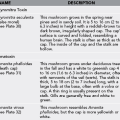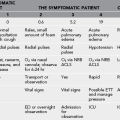Seafood Toxidromes
Ciguatera Fish Poisoning
Signs and Symptoms
1. Onset possible within 15 to 30 minutes of ingestion and generally within 1 to 3 hours; increasing severity over ensuing 4 to 6 hours; almost all victims develop symptoms by 24 hours
2. Abdominal pain, nausea, vomiting, and diarrhea usually occurring 3 to 6 hours after ingestion and possibly persisting for 48 hours
3. Headache, metallic taste, chills, paresthesias (particularly of the extremities and circumoral region), pruritus (particularly of the palms and soles after a delay of 2 to 5 days), tongue and throat numbness or burning, sensation of “carbonation” during swallowing, odontalgia or dental dysesthesias, dysphagia, dysuria, dyspnea, weakness, fatigue, tremor, fasciculations, athetosis, meningismus, aphonia, ataxia, vertigo, pain and weakness in the lower extremities, visual blurring, transient blindness, hyporeflexia, seizures, nasal congestion and dryness, conjunctivitis, maculopapular rash, skin vesiculations, dermatographia, sialorrhea, diaphoresis, arthralgias, myalgias (particularly in the lower back and thighs), painful ejaculation with urethritis, insomnia, bradycardia, hypotension, central respiratory failure, and coma
4. Tachycardia and hypertension possible
5. More severe reactions in persons previously stricken with the poisoning
6. Pathognomonic symptom: reversal of hot and cold tactile perception, which may result from generalized thermal hypersensitivity or paresthesias
7. Pruritus exacerbated by anything that increases skin temperature (blood flow), such as exercise or alcohol consumption
8. If parrot fish ingested, possible second phase, showing locomotor ataxia, dysmetria, and resting or kinetic tremor
Treatment
1. Be aware that therapy is supportive and based on symptoms.
2. Control nausea and vomiting with an antiemetic (prochlorperazine, 2.5 mg IV; ondansetron, 4 mg IV or PO dissolving tablet; or promethazine, 25 mg IM).
3. Control hypotension with intravenous crystalloid volume replacement or oral rehydration if tolerated.
4. For arrhythmias, heart block, hypotension, or severe neurologic symptoms, administer mannitol (20% solution), 1 g/kg IV over 45 to 60 minutes during the acute phase (days 1 to 5). This therapy is not consistently proven to be beneficial.
5. Bradyarrhythmias or excess cholinergic stimulation may respond to atropine (0.5 mg IV, up to 2 mg).
6. For pruritus, administer hydroxyzine, 25 mg PO q6-8h. Cool showers may help. Amitriptyline, 25 mg PO q12h, may relieve pruritus and dysesthesias, as well as emotional depression.
7. Nifedipine (begin with 10 mg PO q8h) has been used to relieve headache.
8. In the recovery phase, avoid ingestion of fish, fish sauces, shellfish, shellfish sauces, alcoholic beverages, and nuts and nut oils.
Clupeotoxin Fish Poisoning
Signs and Symptoms
1. Onset abrupt, within 30 to 60 minutes of ingestion
2. Initially, marked metallic taste, xerostomia, nausea, vomiting, diarrhea, and abdominal pain
3. Next symptoms: chills, headache, diaphoresis, severe paresthesias, muscle cramps, vertigo, malaise, tachycardia, peripheral cyanosis, and hypotension
Scombroid Fish Poisoning
Signs and Symptoms
1. Onset within 15 to 90 minutes of ingestion
2. Flushing (sharply demarcated, exacerbated by ultraviolet exposure, particularly of the face, neck, and upper trunk); sensation of warmth without elevated core temperature; conjunctival hyperemia; pruritus; urticaria; angioneurotic edema; bronchospasm; nausea; vomiting; diarrhea; epigastric pain; abdominal cramps; dysphagia; headache; thirst; pharyngitis; burning of the gingivae; palpitations; tachycardia; dizziness; hypotension; localized numbness of the oropharynx; and rare arrhythmias
3. If untreated, resolution of symptoms generally within 8 to 12 hours
4. Reaction much more severe in a person who is concurrently ingesting isoniazid
Treatment
1. Administer an antihistamine (diphenhydramine, 25 to 50 mg PO or IV; cimetidine, 300 mg, or ranitidine, 50 mg IV). Alternatives are nizatidine, 150 mg PO, or famotidine, 20 mg PO. Combination therapy with both a histamine1 receptor antagonist and a histamine2 receptor antagonist may be more effective than either alone.
2. If the patient is severely ill with facial swelling indicative of an airway obstruction, hypotension, or significant bronchospasm, treat as for an allergic reaction with epinephrine and inhaled bronchodilators in addition to antihistamines (see Chapter 26). Corticosteroids are of no proven benefit for scombroid in the absence of anaphylaxis.
3. Control nausea and vomiting that do not remit after antihistamine administration with an antiemetic (prochlorperazine, 2.5 mg IV; promethazine, 25 mg IM; or ondansetron 4 mg IV or PO dissolving tablet).
4. Treat persistent headache with acetaminophen or an antihistamine (such as cimetidine).
Prevention
1. Make sure that all captured fish are gutted, cooled, and refrigerated or placed on ice or frozen immediately.
2. Do not consume fish that has been handled improperly or carries the odor of ammonia. Fresh fish generally has a sheen or oily rainbow appearance; avoid “dull” fish or those that do not smell fresh.
Tetrodotoxin Fish Poisoning
Signs and Symptoms
1. Onset possibly as rapid as 10 minutes or delayed for up to 4 hours; usually occurs within 30 minutes of ingestion; death may occur within 20 minutes
2. Initial symptoms: oral (lips and tongue) paresthesias, light-headedness, and then general paresthesias
3. Rapidly developing symptoms: hypersalivation, diaphoresis, lethargy, headache, nausea, vomiting, diarrhea, abdominal pain, weakness, ataxia, incoordination, tremor, paralysis, cyanosis, aphonia, dysphagia, seizures, bradycardia, dyspnea, bronchorrhea, bronchospasm, respiratory failure, coma, hypotension, and coagulopathy
4. Gastrointestinal symptoms may be severe and include nausea, vomiting, diarrhea, and abdominal pain
5. Miosis progressing to mydriasis with poor papillary light reflex
6. When mechanical ventilation maintained and no anoxic brain injury present, full mentation maintained with total flaccid paralysis
Treatment
1. Be aware that the toxin is stable in gastric acid and partially inactivated in alkaline solutions.
2. Secure the airway, and administer oxygen.
3. Perform gastric lavage with 2 L of 2% sodium bicarbonate in 200-mL aliquots, followed by placement of 50 to 100 g of activated charcoal in 70% sorbitol solution (or 30 g of “highly activated” charcoal in sorbitol).
4. Further therapy is supportive and based on symptoms. Atropine may be used to treat bradycardia. Pressors that are α-agonists, such as phenylephrine or norepinephrine, may be effective to treat hypotension, taking care to first ensure adequate fluid resuscitation. Cholinesterase inhibitors, such as edrophonium and neostigmine, have met with varying success.
Paralytic Shellfish Poisoning
Signs and Symptoms
1. Within minutes (usually 30 to 60) to a few hours after ingestion of contaminated shellfish, onset of intraoral and perioral paresthesias, notably of the lips, tongue, and gums, which progress rapidly to involve the neck and distal extremities; early onset of vertigo
2. Tingling or burning sensation that becomes numbness
3. Gastroenteritis in only 25% of victims
4. Light-headedness, sensation of “floating,” disequilibrium, incoordination, weakness, hyperreflexia, incoherence, dysarthria, sialorrhea, dysphagia, dysphonia, thirst, diarrhea, abdominal pain, nausea, vomiting, nystagmus, dysmetria, headache, diaphoresis, loss of vision, sensation of loose teeth, chest pain, and tachycardia
5. Flaccid paralysis and respiratory insufficiency 2 to 12 hours after ingestion
6. Unless there is a period of anoxia, patient often awake and alert, although paralyzed
Treatment
1. Secure the airway, and administer oxygen.
2. Do not induce emesis. If the airway is secure, perform gastric lavage with 2 L of 2% sodium bicarbonate in 200-mL aliquots, followed by placement of 50 to 100 g of activated charcoal in 70% sorbitol solution (or 30 g of “highly activated” charcoal in sorbitol).
3. Further therapy is supportive and based on symptoms. Hemoperfusion has met with varying success.
Vibrio Fish Poisoning
Signs and Symptoms
1. Gastroenteric manifestations
a. Ingestion of raw or partially cooked seafood products followed in 6 to 76 hours by explosive diarrhea, nausea, vomiting, headache, abdominal pain, fever, chills, and prostration in the case of V. parahaemolyticus. This is not likely to be the case with V. vulnificus.
c. Hypotension initially secondary to dehydration and then, in immunocompromised individuals, to sepsis
Treatment
1. Treat dehydration and hypotension with intravenous crystalloid fluid replacement.
2. Administer an appropriate antibiotic as soon as a Vibrio infection is suspected.
a. Appropriate antibiotics for sepsis include doxycycline (100 mg IV q12h), ceftazidime (2 g IV q8h), or ciprofloxacin (400 mg IV q12h). Other antibiotics that have been suggested include trimethoprim/sulfamethoxazole, ciprofloxacin, tetracycline, carbenicillin, chloramphenicol, tobramycin, gentamicin, imipenem/cilastatin, meropenem, and many third-generation cephalosporins. A course of oral ciprofloxacin, trimethoprim/sulfamethoxazole, or doxycycline may shorten the course of severe gastroenteritis.
b. For information about antibiotic prophylaxis for marine-acquired wounds, see Chapter 52.
Anisakiasis
Signs and Symptoms
1. Within 1 hour of ingestion of raw fish: severe epigastric pain, nausea, and vomiting, mimicking an acute abdomen
a. If the worm does not implant, it may be coughed up, vomited, or defecated, usually within 48 hours of the meal
b. If the worm is felt in the oropharynx or esophagus, “tingling throat” sensation
2. Intestinal anisakiasis more often delayed in onset (up to 7 days after ingestion) and marked by abdominal pain, nausea, vomiting, diarrhea, and fever
Domoic Acid Intoxication (Amnestic Shellfish Poisoning)
Signs and Symptoms
1. Initial symptoms of nausea, vomiting, abdominal cramps, and diarrhea 1 to 24 hours after ingestion
2. In 15 minutes to 38 hours (median 5 hours) after ingestion of contaminated shellfish, rapid onset of arousal, confusion, disorientation, and memory loss
3. Severe headache, hiccups, arrhythmias, hypotension, seizures, ophthalmoplegia, hemiparesis, mutism, grimacing, agitation, emotional lability, coma, copious bronchial secretions, and pulmonary edema
Botulism
Signs and Symptoms
1. Within 12 to 36 hours of ingestion: nausea, vomiting, abdominal pain, and diarrhea, followed by dry mouth, dysphonia (hoarseness), difficulty swallowing, facial weakness, ptosis, nonreactive or sluggishly reactive pupils, mydriasis, blurred or double vision, descending symmetric muscular weakness leading to paralysis, and bulbar and respiratory paralysis
Treatment
1. Provide ventilatory support.
2. Consider a cathartic if airway is maintained.
3. Administer equine trivalent antitoxin A, B, and E as soon as possible. Initial dose is 10 mL (one vial) every 2 to 4 hours for three to five doses or longer if symptoms persist. Anticipate an anaphylactic reaction to antitoxin.






